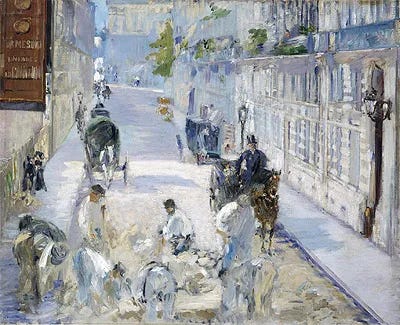“The old Paris is no more”, wrote Baudelaire in an 1861 poem titled “the Swan”. Lamenting the modernization of his beloved Paris, he added “the form of a city changes faster, alas! than a mortal’s heart.”
Baudelaire wasn’t the only one to observe the rapidly changing urban landscape of 19th. century Paris. In the painting below, by Édouard Manet, titled “the road-pavers”, we see the view from Manet’s studio in the rue de Saint-Pétersbourg, looking onto the newly built rue Mosnier (renamed Rue de Berne in 1884) in North-West Paris.
In the foreground we see a group of road-pavers laying out a brand new road. In the background there are two horse-drawn carriages, one of them trying to get past the laborers.
At first glance this appears to be an ordinary impressionistic street-scene, with the characteristic sketch-like brushstrokes, warm sunlight, and pastel tones suggesting a pleasant summer day. But the picture’s subject manner is both more ironic and subversive than one might think. The secret lies in the shuttered windows on the right side of the street.
This was a well-known street for sex-workers, and the tiny apartments were in fact rental hotel-rooms. See the figure in red looking out the window to the right? Or the man and woman chatting on the pavement to the left? This isn’t so much a romantic scene as it is a transactional one. With this knowledge we suddenly see the view in a different light. Is the man in the top hat there by chance or surprised to find a construction site in front of his mistress’ lodgings?
Moreover, the pavers aren’t just renovating the road, they are preparing for the fête nationale, and a new city ordinance has it that the street must be “cleaned up”. Notice the moving-cart in the background on the right? The tenants are being evicted. Or what about the new-looking street-sign on the left? It’s advertising baby-clothing and other products for mothers and children. Which is to say, this is no ordinary street-scene, it’s a depiction of what today would be called gentrification.
The French author Zola visited Manet several times during the creation of this painting, and historians speculate that it influenced his novel Nana. Both Zola and Manet (and for that matter Baudelaire) were exploring broader themes of social change, urban planning, and the sudden emergence of a modern Paris from within the vestiges of the old.
On a technical level this painting also reflects change and disturbance. The composition is unsettled and the perspective is intentionally muddled. For example, consider how large the horse on the left looks compared to the couple standing on the pavement. The pavers loom slightly too large over the foreground, and the browns and greens draw our attention to asymmetrical spaces in the frame. It’s both a beautiful and yet subtly unsettling picture. In this the artist managed to convey his own sense of wonder and bewilderment as the city changed right in front of his very eyes.
What I like most about this painting is that it encourages us to take a closer look, and when we do our experience of it changes. At first glance things appear idyllic, but upon closer examination things aren’t quite as they seem. In this sense the painting is also allegorical. Manet examines the hypocrisies of upper-class morality, and how the glossy nationalistic celebrations are made to cover up (quite literally) the seedy escapades of its prominent and wealthy citizens. Manet observes it all, from his little studio, taking note and painting with unsparing scrutiny the scene as it appears to him. This is what makes the painting stand out as a hybrid realist/impressionist work. Manet doesn’t just depict a changing Paris, he depicts the impression of change as such.
Julian
Ps: paying members can also access a weekly podcast. To upgrade, simply click below.





Correction 1: the sign advertising made to measure children’s clothing is on the left, not (as my text stated) on the right.
Correction 2: the horse in the background is advancing, not turning around (as first stated in my text).
Thank you for sharing this. It gives a perspective of the changes that were taking place then in Paris. A great artist like Manet was documenting these changes.